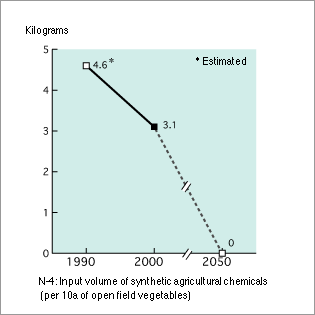ProjectsPast and current JFS projects
Indicators - Nature / Water, Soil, and Air
N-4. Input of Synthetic Agricultural Chemicals (per 10 ares [approximately 1/4 acre] of Open Field Vegetables)
1.Current Values3.1kg / 10a (year 2000)
2.Current Points
(out of a perfect score of 100 by 2050) 33 points
Calculation method:
(Current value – minimum value) / (2050 target value – minimum value) x 100
3. Explanation of Indicator
Synthetic agricultural chemicals have contributed to the dramatic post-war improvement in agricultural productivity in Japan. However, parts of these agricultural chemicals don’t break down and instead adhere to the crops, remain in the soil, enter the atmosphere or run off into streams and rivers. Due to an increase in such health issues as atopy and low reproductive function, people are demanding secure and safe food, soil, and water.
We have chosen this indicator because we believe that reducing the use of agricultural chemicals as much as possible and increasing organic farming using only nutrients (fertilizers) obtained from nature will be of importance in the coming years.
4.Target for 2050
Approaching zero
5.Ideal for the Future
Approaching zero
6. Rationale for Ideal and Target Values
Due to a registration system for agricultural chemicals and to agrochemical residue standards, their use is restricted to levels that are safe for humans, but since they are chemosynthetic substances not occurring in nature it is inevitable that they have an adverse impact on the physiology of wildlife such as insects, fish, and birds in addition, of course, to humans. The ideal value and target for the year 2050 are both approaching zero because the input value should be as low as possible from the standpoint of the precautionary principle.
7. Source
Ministry of Agriculture, Forestry and Fisheries of Japan “Environmental Investigation of Agricultural Production – Input Amounts by Produce”
Related information:
Conservation of Ground Environment, Ministry of the Environment
8. Notes
Because there was no data for 1990, figures were estimated by transferring the volume of agrochemicals shipped. (refer to Ministry of Agriculture, Forestry and Fisheries of Japan “Agrochemical Corner – Transferring Agrochemical Production and Shipping” http://www.maff.go.jp/nouyaku/ sorry Japanese only)
Volume went from approximately 510,000 tons in 1990 to 340,000 tons (decreased to 67% ) in 2000. Assuming provisionally no change in input area, we have estimated the input volume for 1990 to be 3/2 of the 1990 volume, or approximately 4.6kg.



